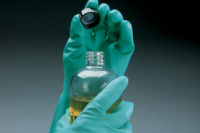When should chemical protective gloves be used?
The answer to this question starts at the evaluation of the specific task that has to be performed. Any task that requires the worker to come in contact with a chemical should require the use of the proper chemical protective gloves, in addition to all other necessary PPE. Note that if the exposure hazard to a chemical can be engineered or administrated out of the task, do this before the use of PPE is considered. PPE is the last resort for protection from the hazard.
How do you choose the right glove?
Once it is determined that chemical protective gloves are necessary for the task, you should look at several chemical and task characteristics:
• splash or immersion
• chemical being handled
• temperature/concentration of the chemical
• length of time the employee will be exposed to the chemical
• dexterity needed for the task
• disposable or reusable glove choice
The Material Safety Data Sheet (MSDS) is a good place to start for information on the chemicals to which the employee will be exposed. Within the MSDS, there is a section that will specify the PPE to be used while handling the chemical. This is where the type of glove or acceptable glove materials are listed that may be used with the chemical per the manufacturer of the chemical or product. If the MSDS is vague, then a call to the manufacturer is in order to determine what glove materials you should select when handling this chemical. Chemical concentration is very important criteria needed when making a glove selection for hand protection from chemical attack. At higher concentrations, many chemical protective gloves do not offer adequate protection to the user.
Manufacturer’s chemical compatibility tools are available to ensure that the glove chosen is compatible with the chemical and chemical concentration. It should be noted that most chemical compatibility tools will give information for pure chemicals, not mixtures. This issue highlights the need to use the MSDS to determine the specific glove that the manufacturer suggests. It is necessary to consider any additional hazards and the appropriate glove characteristics that are needed for protection during the task.
Different glove materials resist different chemicals; no one glove can be suited for all chemical exposures. By use of the manufacturer’s guide, select a glove that is most resistant to the chemicals being used. Remember, the actual chemical compatibility of a given glove material can vary from manufacturer to manufacturer. Selections should be based on the particular manufacturer’s test data.
Learn the lingo
To read a chemical resistance guide, it is important to become familiar with the terminology used:
Breakthrough time: The elapsed time between initial contact of the chemical on the glove surface and the analytical detection on the inside of the glove. Typically a test run is done for a specific challenge time in minutes and then stopped upon detection. When maximum test time is reached and no breakthrough is detected, it is common to see this expressed using the greater than symbol (>) and the number of minutes the challenge test exceeded. This also may be expressed as “ND” for none detected.
Degradation: A change in one or more of the physical properties of a glove due to contact with a chemical. This can appear as a swelling, softening, shrinkage or cracking of the material. For example, a rating of “E” represents excellent, a rating of “G” represents good and so on. This information usually is found in the “key” included with the compatibility guide. A rating of excellent indicates the glove had little or no signs of degradation when exposed to the challenge chemical. **Note, a good degradation rating does not guarantee an acceptable breakthrough time.
Permeation rate: The rate at which a chemical passes through a glove material. This process involves absorption on the glove surface, the diffusion of the chemical through the material, and the desorption on the glove’s inside surface. This is a complex measurement: µg/cm2/MIN (micrograms per square centimeter per minute). This measurement is also limited to the “LDL” or Lower Detection Limit of the equipment used.
Mixtures of chemicals require some consideration. Most manufacturers only test glove materials to individual chemicals and not to mixtures. In these cases a call to the manufacturer of the gloves may be in order to determine if a glove could be used in that mixture and application. If this information is not available from the manufacturer, then select a glove on the basis of the chemical component with the shortest breakthrough time, since it is possible for solvents to carry active ingredients through polymeric materials. When chemical mixtures are in the equation, the end user should proceed with caution or consider testing the agent with the glove they have selected.
What are the most common chemical protective glove materials?
Butyl: A synthetic rubber material that offers the highest permeation resistance to gas and water vapors. Especially suited for use with esters and ketones.
Neoprene: A synthetic rubber material that provides excellent tensile strength and heat resistance. Neoprene is compatible with some acids and caustics. It has moderate abrasion resistance.
Nitrile: A synthetic rubber material that offers chemical and abrasion resistance — a very good general-duty glove. Nitrile also provides protection from oils, greases, petroleum products and some acids and caustics.
PVC (polyvinyl chloride): A synthetic thermoplastic polymer that provides excellent resistance to most acids, fats and petroleum hydrocarbons. Good abrasion resistance.
PVA™ (polyvinyl alcohol): A water-soluble synthetic material that is highly impermeable to gases. Excellent chemical resistance to aromatic and chlorinated solvents. This glove cannot be used in water or water-based solutions.
Viton®: A fluoroelastomer material that provides exceptional chemical resistance to chlorinated and aromatic solvents. Viton is very flexible, but has minimal resistance to cuts and abrasions.
SilverShield®/4H: A lightweight, flexible laminated material that resists permeation from a wide range of toxic and hazardous chemicals. It offers the highest level of overall chemical resistance, but has virtually no cut resistance.
In many cases, the chemical protective glove is the first piece of PPE that a person considers donning before they start a task. It does not take long to perform a hazard assessment or to collect the MSDS sheets for the chemicals being used. This will go a long way toward protecting the employee and keeping your OSHA 300 log clean.



